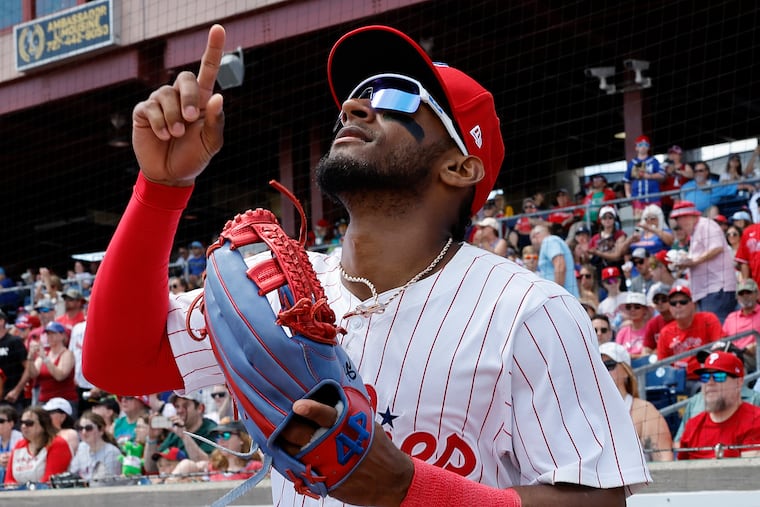The Phillies have a big question with Johan Rojas. They may have to get creative to answer it.
Rojas is great with the glove and, so far, weak with the bat. Baseball history shows how one World Series winner dealt with a similar conundrum.

When people who really love baseball start listing the reasons that they really love baseball, they often end up falling back on a cliché: that every trip to the ballpark offers the promise of seeing something that has never happened before. But as the sport ages and more things happen within it, it gets harder and harder to establish the unique nature of a particular moment or feat or development. The standards for originality start to stretch at the seams. Hey, no one’s ever hit a game-winning home run in the eighth inning or later that clinched a wild-card spot for a franchise west of Toledo at the exact moment that the Northern Hemisphere was experiencing the autumnal equinox. Baseball!
Actually, the opposite of that cliché is the truth. Baseball has so much history, has gone through so many eras and styles of play, and has accumulated so much trivia over time that you can find an interesting and relevant precedent for just about anything. And the fun is digging through the game’s past to find one of those precedents.
Which brings us, of course, to the 2024 Phillies and Johan Rojas.
Rojas is probably going to be in the Phillies’ opening-day lineup Friday against the Braves, and he’ll be given every opportunity to win the everyday job in center field. Everyone knows this. Everyone knows that Rojas is a wonderful defensive outfielder, that his speed and ability to track down fly balls should help the Phillies immeasurably in this latest era of Major League Baseball, when managers can no longer shift their outfielders to the precise place where opposing batters are most likely to hit the ball. And everyone knows what Rojas must do to stay in the lineup. All he has to do is hit a little.
Can he? That’s the big question about him. Maybe the biggest about the Phillies’ entire lineup. Rojas batted .302, with a .771 on-base-plus-slugging percentage, over his 149 at-bats as a rookie during the 2023 regular season. No issues there. But then the playoffs began, and the Phillies might as well have pulled a slow-pitch softball player out of the Citizens Bank Park bleachers and batted him ninth. Rojas went 4-for-43 with 15 strikeouts during the postseason, and after he batted just .170 this spring, with a terrible .478 OPS, there’s concern that any time manager Rob Thomson writes Rojas’ name on the lineup card, he might as well be leaving the No. 9 spot blank.
» READ MORE: The Phillies believe Johan Rojas can be ‘electric’ as a hitter. But there’s still plenty of work ahead.
In fact, someone asked Thomson during a Zoom call Thursday whether he would consider pinch-hitting for Rojas in crucial, late-game situations. It’s not as if Thomson doesn’t have choices: a left-handed bat in Brandon Marsh, a right-handed bat in Whit Merrifield, even Christian Pache.
“I’ve talked to Johan about it,” Thomson said. “Talked to a few people about it. We’ve got so much depth now. We’ve got so many options. Maybe you’ve got Marsh on the bench. You’ve got Whit on the bench. Those are guys I feel really confident with taking a really good at-bat, even against a right-handed pitcher for Whit.”
So the Phillies have a potential hole in their lineup, and they don’t want it to be the difference between their making a deep playoff run and not making such a run — between winning the World Series and never getting there.
Which brings us, of course, to Ray Oyler and the 1968 Detroit Tigers.
See? History.
The ‘68 Tigers were a great team, one built similarly (with all the requisite caveats about the modernization of the sport) to these recent Phillies teams. They had two aces in their rotation: Denny McLain and Mickey Lolich. They had a stacked lineup; they led the American League in runs, home runs, and slugging percentage. They won 103 regular-season games. And in Oyler, they had a hole in their lineup that was more gaping than Rojas promises to be for the Phils.
Oyler was one of the best defensive shortstops in the majors, maybe the best. His fielding percentage in ‘68, .977, was 15 points higher than the average AL shortstop’s. But whatever benefits Oyler gave the Tigers in the field were minimal compared to his deficiencies at the plate: Over 247 plate appearances, he batted .135 with a .186 slugging percentage. Yeah, 1968 was “The Year of the Pitcher,” but good Lord.
Desperate to squeeze more offense out of his lineup, Tigers manager Mayo Smith did something wild: Late in the season, he benched Oyler and moved outfielder Mickey Stanley to shortstop. Stanley had never played shortstop before, but the gamble worked. The Tigers beat the St. Louis Cardinals in the World Series, and though Stanley hit just .214 with one extra-base hit over the Series’ seven games, his production was still better than what Oyler likely would have provided.
» READ MORE: The honeymoon is over. It’s World Series or bust for the 2024 Phillies.
Now, is Thomson going to pull a reverse Mayo and, in the worst-case scenario for Rojas, send Trea Turner out to center field? Yeah, probably not. But in scrolling through an old notes file Thursday, I came across this quote from Elliott Avent, Turner’s head coach at North Carolina State:
“He was in triple A, and one time, they were here playing the Durham Bulls. They put him in center field, which I thought was comical. He played like he’d been out there his whole life.”
So if it happens, you heard it here first. And whatever you do, don’t you dare call it unprecedented.